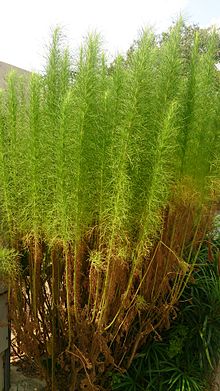Species of flowering plant
Artemisia scoparia
Scientific classification
Kingdom:
Plantae
Clade :
Tracheophytes
Clade :
Angiosperms
Clade :
Eudicots
Clade :
Asterids
Order:
Asterales
Family:
Asteraceae
Genus:
Artemisia
Species:
A. scoparia
Binomial name
Artemisia scoparia
Synonyms [ 3]
Artemisia capillaris Miq.
Artemisia capillaris var. scoparia (Waldst. & Kit.) Pamp.
Artemisia elegans Roxb. 1814[ 2]
Artemisia gracilis L'Hér. ex DC.
Artemisia hallaisanensis var. formosana Pamp.
Artemisia kohatica Klatt
Artemisia piperita Pall. ex Ledeb.
Artemisia sachaliensis Tilesius ex Besser
Artemisia scoparioides Grossh.
Artemisia trichophylla Wall. ex DC.
Draconia capillaris (Thunb.) Soják
Draconia scoparia (Waldst. & Kit.) Soják
Oligosporus scoparius (Waldst. & Kit.) Less.
Artemisia scoparia Eurasian species in the genus Artemisia sunflower family . It is widespread across much of Eurasia from France to Japan , including China , India , Russia , Germany , Poland , central + southwest Asia , etc.[ 4] [ 5]
The English common name of Artemisia scoparia is virgate wormwood ,[ 6] capillary wormwood ,[ 6] redstem wormwood . In Mandarin Chinese it is known as yīn chén (Traditional: 茵陳) and it is an important traditional Chinese medicine,[citation needed [ 7] Artemisia capillaris [ 8]
Chemical constituents
Capillarisin [ 9] Chlorogenic acid butyl ester 6,7-Dimethylesculetin Isosabandin Magnolioside (isoscopoletin-β-D-glucopyranoside)7-Methoxycoumarin 7-Methylesculetin Sabandin A [ 10] Sabandin B Scoparone (6,7-dimethoxycoumarin) [ 11] Scopoletin β-Sitosterol Capillin
References
^ Tropicos search for Artemisia scoparia ^ Roxb. Hort. Bengal. 61 1814
^ The Plant List Artemisia scoparia Waldst. & Kitam. ^ Flora of China, 猪毛蒿 zhu mao hao, Artemisia scoparia Waldstein & Kitaibel, Descr. Icon. Pl. Hung. 1: 66. 1802. ^ Altervista Flora Italiana, Assenzio scopario, Artemisia scoparia Waldst. & Kit. includes photos and European distribution map^ a b English Names for Korean Native Plants (PDF) . Pocheon: Korea National Arboretum . 2015. pp. 360– 361. ISBN 978-89-97450-98-5 the original (PDF) on 25 May 2017. Retrieved 25 January 2017 – via Korea Forest Service .^ Ding, Jiwei; Wang, Linlin; He, Chunnian; Zhao, Jun; Si, Lijun; Huang, Hua (2021-06-12). "Artemisia scoparia: Traditional uses, active constituents and pharmacological effects" . Journal of Ethnopharmacology . 273 : 113960. doi :10.1016/j.jep.2021.113960 . ISSN 0378-8741 . PMID 33636317 . S2CID 232065726 . ^ Jaggi KS; Gangal SV (1987). "Isolation and identification of pollen allergens of Artemisia scoparia ". J Allergy Clin Immunol 80 (4): 569– 572. doi :10.1016/0091-6749(87)90008-X . PMID 3668120 . ^ "Chemical Study on Artemisia scoparia" . Archived from the original on September 30, 2007. Retrieved November 17, 2006 .^ Ali MS; Jahangir M; Saleem M (2003). "Structural distinction between sabandins A and B from Artemisia scoparia waldst. (Asteraceae) ". Nat. Prod. Res. 17 (1): 1– 4. doi :10.1080/10575630290020640 . PMID 12674134 . S2CID 32672104 . ^ Hoult JR; Payá M (1996). "Pharmacological and biochemical actions of simple coumarins: natural products with therapeutic potential". Gen. Pharmacol. 27 (4): 713– 722. doi :10.1016/0306-3623(95)02112-4 . PMID 8853310 .
